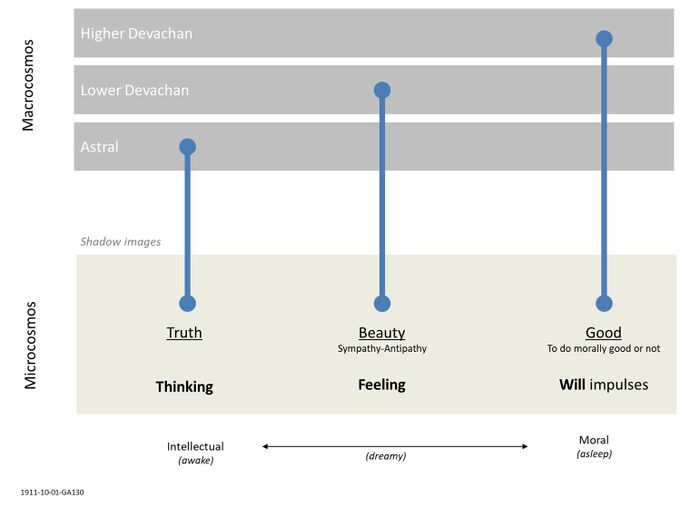Active soul participation
In the context of studying and living spiritual science and anthroposophy, 'active soul participation' is a key characteristic living in the forces of feeling and willing beyond intellectual thinking.
See also: Christ Module 15 - Study of Spiritual Science and the Mystery of Golgotha and Reverse ritual
Aspects
- the what
- the why (see Discussion Note [1] below)
Illustrations
Schema FMC00.213 relate Thinking Feeling Willing (TFW) activities of the human soul to the three worlds and Truth Beauty Good (TBG).
Lecture coverage and references
It is well, now and then, to recollect that the point of importance in Anthroposophy is not so much the learning of certain things as theory or doctrine, but that we should continually enter in greater detail into the questions and enigmas of life. Some people may perhaps say: All that is necessary to know of Anthroposophy for use in life could be comfortably contained in a small pamphlet of sixty pages or so; everyone could possess a copy and would then be convinced as to the nature of man, reincarnation and karma, and the evolution of humanity on the earth, — and could go through life needing nothing further.
A person who would like to have that carried out might perhaps suggest:
‘Why does not the Anthroposophical Movement distribute as many copies as possible of a booklet containing these principal points of view, so that everyone might acquire a copy and be able to convince himself? Why does the Anthroposophical Society adopt the curious method of holding meetings week after week, assembling all those interested or likely to become interested for the purpose of constantly recapitulating what might comfortably be reduced to a sixty-page pamphlet? What can these Anthroposophists possibly have to say to their followers, week after week?’
There may be certain orders of mind of our day who would like to have a small outline of Anthroposophy which they could keep in their waistcoat pockets, and thus study what it is most important to know. We must, however, over and over again, bring to mind the fact that nothing can be done in this way with Anthroposophy. There can be no ‘tabloid-knowledge!’
Although Anthroposophy does depend both on knowledge and perception, it does not consist of mere ‘phrases,’ but of very definite knowledge. But it is not enough merely to acquire this knowledge as a general conviction according to present-day methods, and then rest satisfied. For the point in question is not merely that one should acquire the conviction and know that man lives many lives and that there are causal conditions which pass over from one life into another, that there is such a thing as reincarnation, as karma.
The beneficial effects of Anthroposophy do not lie in the spreading of this knowledge, but are felt in the constant and repeated study of all the details connected with it, and in allowing the teaching to work upon one's soul.
It does one no good simply to believe that man lives more than once and that there is such a law as that of reincarnation, karma, and so on. The mere belief in this will not carry one far. As regards the real depths of life there is not much difference between the soul of a man who knows of reincarnation and karma and one who knows nothing of it.
In an anthroposophical sense our soul is only changed if we constantly study, not only the generalities, but the deeper things that Spiritual Science can teach us. That is why it is a good thing that we should over and over again consider how the various details of life appear in the light of the Anthroposophical conception. It is by no means sufficient merely to know that there is a great law of destiny establishing a connection between the past deeds, feelings and thoughts of a man and his present and future experiences.
Anthroposophy will only become a life-factor when we can apply this general doctrine to the different experiences of life, when we become able to put our whole soul into such a position, that we obtain an entirely new outlook on life.
1914-05-08-GA69D has an extended coverage worth reading, free translation paraphrased below:
It's understandable that such explanations do not find a lot of understanding in our current times. A trivial comparison will illustrate. Suppose there are two pamflets for two lectures somewhere, one animated with movie and another one without .. what would speak most to people? The one where they can just go and passively attend and everything is being spoon-fed without the need for them to be active in any way. This can not work for spiritual science. Although imagery perceived clairvoyantly could also be presented with images, I have chose to work solely via the word, so it can work on one's thinking and feeling. Spiritual science is only possible with active soul participation.
Further the example is made of a published article suggesting to make a short movie about Spinoza's Ethica, and the total lack of impact if one is fed such movies without any active work in the soul.
It's part of our zeitgeist that people have a tendency to let everything work on them passively. Spiritual science however needs to call for the opposite. The soul needs to actively work everything by itself. And through such work the soul is being fed and strengthened by what it needs most for soul and spiritual health: activity; strengthening of the will, of the forces of thinking and feeling.
And he continues to make the link how this will be necessary when confronted with the lack of love 1915-06-13-GA159
The true reason why we come together in our Group-meetings is not that of learning in a theoretical way one or the other truth which spiritual science can reveal, but the true reason why we assemble is that everything that lives in our souls should be filled with the spirit that can flow out of spiritual science. The essential point is not WHAT we think, but HOW we think, feel and will.
In 1921-10-14-GA207 some fun is made of the need for having Outline of Esoteric as a movie, or a 'fully illustrated edition':
This is truly the I-culture. It is prevailing more and more. Anthroposophical spiritual science comes along, however, and with that one cannot work in this way. A modern theologian said that he would not read the Akashic Chronicle even if it were bestowed on him in a special illustrated edition; but he need not have feared that he would receive the Akashic Chronicle in a special illustrated edition, for it must be acquired in such a way that one participates in an inwardly forming way. Even if once one were really to fix in a symbolic, artistic way what is found in the Akashic Chronicle, this theologian still could not do anything with it because he primarily values the illustrations.
With anthroposophical spiritual science, one must participate inwardly, for otherwise one naturally hears only the words, which can be regarded arbitrarily as fantasy. This inner participation, however, one must learn to love. One must resolve to do this. It is uncomfortable, but it becomes noticeable, if one resolves to do it, that this activity refreshes, that it makes the human being fresher in soul and body. I know that many people raise objections concerning this becoming refreshed, but they would very much like to attain through merely passive thinking what should be attained through an active participation of the astral body in a difficult wrestling for comprehension, just as that theologian would have been most content to have the entire Outline of Occult Science played out for him in a movie. This is just how he uses his concepts in the essay where he speaks of a “special illustrated edition of the Akashic Chronicle.”
Briefly, by means of anthroposophical spiritual science something comes into activity that is no longer merely the I but that includes the astral body. There are certainly those people who sense this when they read an anthroposophical book. As they read it they sense something; something stirs in them. Before things were disposed to move inwardly only passively, as thought shadows. Now something like an active intellect begins to stir in them. Something emerges from them as if inwardly they had lice, and then they become so nervous about this inner stirring that they say: this is unhealthy. Then they complain about the difficult things with which people in anthroposophical spiritual science are challenged. Especially those who then observe people who are noticeably affected inwardly in this way — their brothers, sisters, aunts, and uncles — complain that anthroposophy is something that makes people nervous.
GA221-L3 so 1923-02-04 schematics alone no use, doing the work necessary, needs to happen in one's soul
GA218 - L6: not dry brain but feeling and willing
GA217-L7 becoming tired
GA153 or 155-L1 movie Spinoza
Discussion
Note 1 - why are we doing this
When meditating, studying, praying .. you may ponder the question how this contributes, versus acting in the world. Not that acting in the world is not an important responsability (it is an essential element in rosecrucianism), but put that to the side as a separate discussion. Our soul activity on Earth matters for the souls of the deceased, and incarnating souls. In this way we contribute to the future, and our work has meaning for other souls.
- The lecture extract of 1915-06-15-GA159 on Communicating over spiritual science explains that people working in groups on spiritual science, feed up 'nourishment for the spiritual hierarchies' so as to fructify the souls that incarnate in the next cultural age. This important principle underlies the workings of the Mysteries throughout the ages, and this way humanity advances by receiving the seeds in their astral body. See also the principle of 'creation of a new center' through joint ideals on Christ Module 7 - Cosmic dimension (re Schema FMC00.188)
- The lecture extract of 1921-01-22-GA203 on Planets hosting beings at various stages of evolution explains that human beings now receive spiritual instructions during death and a new birth, in the process of their descent between the Midnight Hour and incarnation.
Related pages
- Notes on the study process
- Reverse ritual
- Christ Module 15 - Study of Spiritual Science and the Mystery of Golgotha
- Seeds for future worlds

